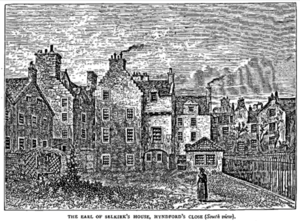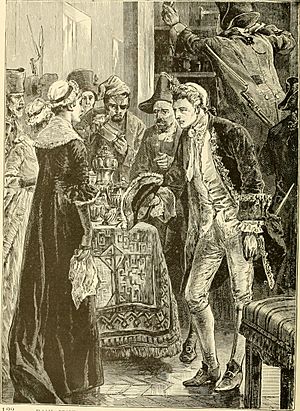Dunbar Douglas, 4th Earl of Selkirk facts for kids
Quick facts for kids
The Earl of Selkirk
FRSE
|
|
|---|---|
| Representative Peer for Scotland | |
| In office 1787–1799 |
|
| Succeeded by | The Earl of Galloway |
| Personal details | |
| Born |
Dunbar Hamilton
1 December 1722 |
| Died | 24 June 1799 (aged 76) |
| Spouse |
Helen Hamilton
(m. 1758) |
| Relations | Lord Basil Hamilton (grandfather) |
| Parents | Isabella Mackenzie Basil Hamilton |
| Alma mater | University of Glasgow |
Dunbar Hamilton Douglas, 4th Earl of Selkirk (born December 1, 1722 – died June 24, 1799) was an important Scottish nobleman. He was also a Fellow of the Royal Society of Edinburgh, which means he was a respected scholar and scientist.
Early Life and Education
Dunbar Hamilton was born in 1722. His parents were Isabella Mackenzie and Basil Hamilton, who was a Member of Parliament. He had one sister named Mary.
When he was 22, in 1744, he became the 4th Earl of Selkirk. At this time, he changed his name to Dunbar Douglas. This was a common practice for noble families.
He went to Glasgow University starting in 1739. He was greatly influenced by his teacher, Francis Hutcheson, who taught moral philosophy. In 1745, he received an honorary degree called a Doctor of Civil Law.
Career and Public Service
In 1742, before he became Earl, Dunbar lived in a large house in Edinburgh. This house was located on Hyndford's Close, near the famous Royal Mile.
The Earl of Selkirk supported the government during the Jacobite Rising of 1745. This was a time when some people wanted to bring back the old royal family to the throne.
He held several important positions. From 1766 to 1768, he was the Rector of the University of Glasgow. This is a high-ranking position in a university. He also served as the Lord Lieutenant of Kirkcudbright. This role meant he was the King's representative in that area. From 1787, he was chosen as a representative peer for Scotland. This meant he represented Scottish nobles in the British Parliament.
In 1782, he joined a group called the Society for Constitutional Information. This group worked to improve how the government worked and to give more people a say.
In 1785, he became a Fellow of the Royal Society of Edinburgh. This is a group for important thinkers and scientists. Famous people like Adam Smith helped him become a member.
Raid by John Paul Jones
In 1778, during the American Revolutionary War, the Earl of Selkirk's home was targeted. An American naval commander named John Paul Jones sailed his ship, the Ranger, to St Mary's Isle.
Jones planned to kidnap the Earl. However, when he arrived, only the Countess and her young children were at home. Instead of kidnapping, Jones's men took the family's silver. This event is a famous story from the American Revolutionary War.
Family Life
On December 3, 1758, Lord Selkirk married Helen Hamilton. She was the daughter of Hon. John Hamilton.
Lord Selkirk and Helen had seven sons and three daughters. Sadly, six of their sons passed away before their father. Their youngest son, Thomas, became the 5th Earl of Selkirk after his father died.
Some of their children included:
- Sholto Basil Douglas (1759–1760)
- Basil William Douglas, Lord Daer (1760–1794)
- John Douglas, Lord Daer (1765–1797)
- Hon. Dunbar Douglas (1766–1796), who was a Commander in the Royal Navy.
- Hon. Alexander Douglas (1767–1794), a Captain in the army.
- Lady Helen Hamilton Douglas (around 1768–1837), who married Sir James Hall, 4th Baronet.
- Hon. David Douglas (1769–1770)
- Thomas Douglas, 5th Earl of Selkirk (1771–1820)
- Lady Elizabeth Douglas (around 1789–1814)
- Lady Katherine Douglas (around 1790–1848)
Lord Selkirk passed away on June 24, 1799, at his home in Edinburgh. He was buried at Holyrood Abbey.



